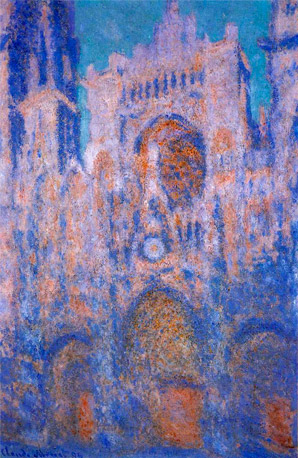
In the recording project presented below I explored multiple versions of Debussy’s Syrinx for flute solo. I was inspired by Claude Monet, who depicts the facade of Rouen Cathedral in different times of the day and year, reflecting changes of mood in shades and colours. In his Exercises in Style Raymond Quenault tells the same banal story 99 times, each in different style of writing, and there are many other examples for multiple readings of theatrical works. Looking for ways for applying this approach in musical performance, I started by focusing on tone qualities, such as vibrato, dynamics and articulation, and on temporal aspects, including tempo and timing. But the different technical focal points were not sufficient for creating versions that are artistically convincing. Building on the theatrical context in which piece was conceived, I then developed my own imaginary narrative for each one of the versions. Following Debussy’s evocative example in his two books of Préludes for piano, the versions carry an after-thought personal descriptive titles, which put me in the right mind-set in performance.
Several questions came up through the process: How to relate to the score? What information is actually provided by the score as opposed to the features attributed to it? And what is the role of the performer in shaping the musical experience on the continuum between execution and creation?
Where to start? Two references usually serve performers as departure points for their exploration: the score and the legacy of past performances. In the case of Syrinx, both references afford opportunities for great freedom.
Debussy’s Syrinx was written in 1913 as an incidental music for Gabriel Mourey’s dramatic poem Psyché. Louis Fleury, who is the dedicatee of the piece, premiered it privately at the same year in Paris. Jobert published the first edition in 1927, nine years after Debussy’s death. It is not clear what copy Jobert used for preparing his edition, as Fleury seems to be the only one who had a copy of the piece. Jobert’s edition served as the only reference available up until the late 20th century. The Wiener Urtext Edition from 1996 is based on a manuscript found at a private collection in Brussels, but the manuscript is not without problems: it consists of two or possibly three different kinds of handwriting, probably none by Debussy. And it is assumed that it is the copy used by Fleury for his performances.
There are several differences between the first edition and this manuscript. The most important one is that it is actually not a piece for flute solo but part of a dialogue scene, in which music and text are intertwined. According to Orledge (1982), the original piece did not include bar lines, which were added in Jobert’s publication by Marcel Moyse. The important to remember is that we actually don’t have a reliable manuscript, and the common practice of performing Syrinx as a solo flute piece is not historically accurate.
As for the recording legacy of the piece: There are a vast number of recordings of Syrinx made since 1950. Looking into early recordings, six historical recordings were made by 1950, which is a relatively large number of recordings of a new piece. As we can see from the tempo graph of the opening section, Syrinx is performed quite freely, and generally speaking, there is an agreement between the performers regarding where they alter the tempo. The recording by Georges Barrère stands out with the widest tempo fluctuations and provides an interesting perspective into the discussion of what’s possible. The freedom taken here is especially interesting if taking into account that Barrère was one of the founding members of the French School, which is closely associated with the piece.

Marcel Moyse (France, 1889-1984), rec. 1928
René Le Roy ((France, 1898-1985), rec. in 1939
Georges Barrère (France, 1876-1944), live rec. 1939
Jean-Pierre Rampal (France, 1922-2000), rec. 1949
Martin Ruderman (USA, 1907-1994), rec. 1947-8
William Kincaid (U.S.A., 1895-1967), rec. 1950
© 2021 Abigail Dolan. All Rights Reserved. Created by FLVN
| Cookie | Duration | Description |
|---|---|---|
| cookielawinfo-checbox-analytics | 11 months | This cookie is set by GDPR Cookie Consent plugin. The cookie is used to store the user consent for the cookies in the category "Analytics". |
| cookielawinfo-checbox-functional | 11 months | The cookie is set by GDPR cookie consent to record the user consent for the cookies in the category "Functional". |
| cookielawinfo-checbox-others | 11 months | This cookie is set by GDPR Cookie Consent plugin. The cookie is used to store the user consent for the cookies in the category "Other. |
| cookielawinfo-checkbox-necessary | 11 months | This cookie is set by GDPR Cookie Consent plugin. The cookies is used to store the user consent for the cookies in the category "Necessary". |
| cookielawinfo-checkbox-performance | 11 months | This cookie is set by GDPR Cookie Consent plugin. The cookie is used to store the user consent for the cookies in the category "Performance". |
| viewed_cookie_policy | 11 months | The cookie is set by the GDPR Cookie Consent plugin and is used to store whether or not user has consented to the use of cookies. It does not store any personal data. |